NCERT Solutions for Miscellaneous Exercise Chapter 6 Class 12 - Application of Derivatives
CBSE Class 12th Exam Date:01 Jan' 26 - 14 Feb' 26
Derivatives, a key concept in calculus, have practical applications in various fields like physics, business, and everyday life. They are used to analyse rates of change, predict future trends, and optimise processes. The "Application of Derivatives" chapter of the NCERT includes all these topics. After studying this chapter, you came across the concept of instantaneous change, increasing and decreasing functions, local maxima and minima, and absolute maxima and minima. In this miscellaneous exercise of Chapter 6, Class 12 Application of Derivatives, you will find various questions from each topic, which will help you understand the concept with clarity. These NCERT Solutions are prepared by the subject matter experts at Careers360, which will help you to learn the concept and approach better.
This Story also Contains
- Application of Derivatives: Miscellaneous Exercise
- Topics covered in Chapter 6 Application of Derivatives: Miscellaneous Exercise
- NCERT Solutions Subject Wise
- Subject-wise NCERT Exemplar solutions
Application of Derivatives: Miscellaneous Exercise
Question:1(a) Using differentials, find the approximate value of each of the following:
Answer:
Let $y = x^\frac{1}{4}$ and $x = \frac{16}{81} \ and \ \Delta x = \frac{1}{81}$
$\Delta y = (x+\Delta x)^\frac{1}{4}-x^\frac{1}{4}$
$= (\frac{16}{81}+\frac{1}{81})^\frac{1}{4}-(\frac{16}{81})^\frac{1}{4}$
$(\frac{17}{81})^\frac{1}{4} = \Delta y + \frac{2}{3}$
Now, we know that $\Delta y$ is approximate equals to dy
So,
$dy = \frac{dy}{dx}.\Delta x \\ = \frac{1}{4x^\frac{3}{4}}.\frac{1}{81} \ \ \ \ \ \ \ (\because y = x^\frac{1}{4} \ and \ \Delta x = \frac{1}{81})\\ = \frac{1}{4(\frac{16}{81})^\frac{3}{4}}.\frac{1}{81} = \frac{27}{4\times 8}.\frac{1}{81} = \frac{1}{96}$
Now,
$(\frac{17}{81})^\frac{1}{4} = \Delta y + \frac{2}{3} = \frac{1}{96}+\frac{2}{3} = \frac{65}{96} = 0.677$
Hence, $(\frac{17}{81})^\frac{1}{4}$ is approximately equal to 0.677
Question:1 Using differentials, find the approximate value of each of the following:
$( 33) ^{-1/5 }$
Answer:
Let $y = x^\frac{-1}{5}$ and $x = 32 \ and \ \Delta x = 1$
$\Delta y = (x+\Delta x)^\frac{-1}{5}-x^\frac{-1}{5}$
$= (32+1)^\frac{-1}{5}-(32)^\frac{-1}{5}$
$(33)^\frac{-1}{4} = \Delta y + \frac{1}{2}$
Now, we know that $\Delta y$ is approximately equals to dy
So,
$dy = \frac{dy}{dx}.\Delta x \\ = \frac{-1}{5x^\frac{6}{5}}.1 \ \ \ \ \ \ \ (\because y = x^\frac{-1}{5} \ and \ \Delta x = 1)\\ = \frac{-1}{5(32)^\frac{6}{5}}.1 = \frac{-1}{5\times 64}.1= \frac{-1}{320}$
Now,
$(33)^\frac{-1}{5} = \Delta y + \frac{1}{2} = \frac{-1}{320}+\frac{1}{2} = \frac{159}{320} = 0.497$
Hence, $(33)^\frac{-1}{5}$ is approximately equals to 0.497
Question:2. Show that the function given by $f ( x ) = \frac{\log x}{x}$ has maximum at x = e.
Answer:
Given function is
$f ( x ) = \frac{\log x}{x}$
$f^{'}(x) = \frac{1}{x}.\frac{1}{x} + log x\frac{-1}{x^2} = \frac{1}{x^2}(1-\log x)$
$f^{'}(x) =0 \\ \frac{1}{x^2}(1-\log x) = 0\\ \frac{1}{x^2} \neq 0 \ So \ log x = 1\Rightarrow x = e$
Hence, x =e is the critical point
Now,
$f^{''}(x) = \frac{-2x}{x^3}(1-\log x)+\frac{1}{x^2}(-\frac{1}{x}) = \frac{1}{x^3}(-2x+2xlog x-1)\\ f^{''(e)} = \frac{-1}{e^3} < 0$
Hence, x = e is the point of maxima
Question:3(i) Find the intervals in which the function f given by $f (x) = \frac{4 \sin x - 2x - x \cos x }{2 + \cos x }$ is
increasing
Answer:
Given function is
$f (x) = \frac{4 \sin x - 2x - x \cos x }{2 + \cos x }$
$f^{'}(x) = \frac{(4\cos x - 2-\cos x+x\sin x)(2+\cos x)-(4\sin x - 2x - x\cos x )(-\sin x)}{(2+\cos x)^2}$
$=\frac{4\cos x - \cos^2x}{2+\cos x}$
$f^{'}(x)=0\\ \frac{4\cos x - \cos^2x}{2+\cos x} =0\\ \cos x(4-\cos x) = 0\\ \cos x = 0 \ \ \ \ \ \ \ and \ \ \ \ \ \ \ \ \ \ \ \cos x =4$
But $\cos x \neq 4$
So,
$\cos x = 0 \\ x = \frac{\pi}{2} \ and \ \frac{3\pi}{2}$
Now three ranges are there $\left ( 0,\frac{\pi}{2} \right ),\left ( \frac{\pi}{2},\frac{3\pi}{2} \right ) \ and \ \left ( \frac{3\pi}{2},2\pi \right )$
In interval $\left ( 0,\frac{\pi}{2} \right ) \ and \ \left ( \frac{3\pi}{2},2\pi \right )$ , $f^{'}(x) > 0$
Hence, the given function $f (x) = \frac{4 \sin x - 2x - x \cos x }{2 + \cos x }$ is increasing in the interval $\left ( 0,\frac{\pi}{2} \right ) \ and \ \left ( \frac{3\pi}{2},2\pi \right )$
in interval $,\left ( \frac{\pi}{2},\frac{3\pi}{2} \right ), f^{'}(x) < 0$ so function is decreasing in this inter
Question:3 (ii) Find the intervals in which the function f given by f x is equal to
$f (x) = \frac{4 \sin x - 2x - x \cos x }{2 + \cos x }$ is
decreasing
Answer:
Given function is
$f (x) = \frac{4 \sin x - 2x - x \cos x }{2 + \cos x }$
$f^{'}(x) = \frac{(4\cos x - 2-\cos x+x\sin x)(2+\cos x)-(4\sin x - 2x - x\cos x )(-\sin x)}{(2+\cos x)^2}$
$=\frac{4\cos x - \cos^2x}{2+\cos x}$
$f^{'}(x)=0\\ \frac{4\cos x - \cos^2x}{2+\cos x} =0\\ \cos x(4-\cos x) = 0\\ \cos x = 0 \ \ \ \ \ \ \ and \ \ \ \ \ \ \ \ \ \ \ \cos x =4$
But $\cos x \neq 4$
So,
$\cos x = 0 \\ x = \frac{\pi}{2} \ and \ \frac{3\pi}{2}$
Now three ranges are there $\left ( 0,\frac{\pi}{2} \right ),\left ( \frac{\pi}{2},\frac{3\pi}{2} \right ) \ and \ \left ( \frac{3\pi}{2},2\pi \right )$
In interval $\left ( 0,\frac{\pi}{2} \right ) \ and \ \left ( \frac{3\pi}{2},2\pi \right )$ , $f^{'}(x) > 0$
Hence, given function $f (x) = \frac{4 \sin x - 2x - x \cos x }{2 + \cos x }$ is increasing in interval $\left ( 0,\frac{\pi}{2} \right ) \ and \ \left ( \frac{3\pi}{2},2\pi \right )$
in interval $,\left ( \frac{\pi}{2},\frac{3\pi}{2} \right ), f^{'}(x) < 0$
Hence, given function $f (x) = \frac{4 \sin x - 2x - x \cos x }{2 + \cos x }$ is decreasing in interval $,\left ( \frac{\pi}{2},\frac{3\pi}{2} \right )$
Question:4(i) Find the intervals in which the function f given by $f (x) = x ^3 + \frac{1}{x^3}, x \neq 0$
Increasing
Answer:
Given function is
$f (x) = x ^3 + \frac{1}{x^3}$
$f^{'} (x) = 3x ^2 + \frac{-3x^2}{x^4}\\ f^{'}(x) = 0\\ 3x ^2 + \frac{-3x^2}{x^4} = 0\\ x^4 = 1\\ x = \pm1$
Hence, three intervals are their $(-\infty,-1),(-1,1) \ and (1,\infty)$
In interval $(-\infty,-1) \ and \ (1,\infty) , f^{'})x > 0$
Hence, given function $f (x) = x ^3 + \frac{1}{x^3}$ is increasing in interval $(-\infty,-1) \ and \ (1,\infty)$
In interval (-1,1) , $f^{'}(x)< 0$
Hence, given function $f (x) = x ^3 + \frac{1}{x^3}$ is decreasing in interval (-1,1)
Question:4(ii) Find the intervals in which the function f given by $f ( x) = x ^3 + \frac{1}{x^3} , x \neq 0$
decreasing
Answer:
Given function is
$f (x) = x ^3 + \frac{1}{x^3}$
$f^{'} (x) = 3x ^2 + \frac{-3x^2}{x^4}\\ f^{'}(x) = 0\\ 3x ^2 + \frac{-3x^2}{x^4} = 0\\ x^4 = 1\\ x = \pm1$
 Hence, three intervals are their $(-\infty,-1),(-1,1) \ and (1,\infty)$
Hence, three intervals are their $(-\infty,-1),(-1,1) \ and (1,\infty)$
In interval $(-\infty,-1) \ and \ (1,\infty) , f^{'})x > 0$
Hence, given function $f (x) = x ^3 + \frac{1}{x^3}$ is increasing in interval $(-\infty,-1) \ and \ (1,\infty)$
In interval (-1,1) , $f^{'}(x)< 0$
Hence, given function $f (x) = x ^3 + \frac{1}{x^3}$ is decreasing in interval (-1,1)
Answer:
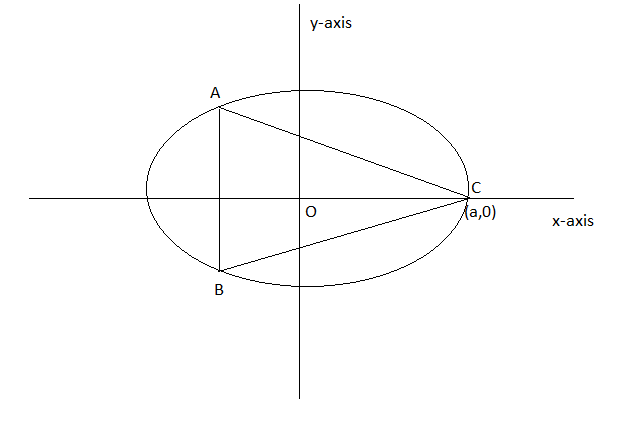 Given the equation of the ellipse
Given the equation of the ellipse
$\frac{x ^2 }{a^2}+ \frac{y^2}{b^2 } = 1$
Now, we know that ellipse is symmetrical about x and y-axis. Therefore, let's assume coordinates of A = (-n,m) then,
Now,
Put(-n,m) in equation of ellipse
we will get
$m = \pm \frac{b}{a}.\sqrt{a^2-n^2}$
Therefore, Now
Coordinates of A = $\left ( -n,\frac{b}{a}.\sqrt{a^2-n^2} \right )$
Coordinates of B = $\left ( -n,-\frac{b}{a}.\sqrt{a^2-n^2} \right )$
Now,
Length AB(base) = $2\frac{b}{a}.\sqrt{a^2-n^2}$
And height of triangle ABC = (a+n)
Now,
Area of triangle = $\frac{1}{2}bh$
$A = \frac{1}{2}.\frac{2b}{a}.\sqrt{a^2-n^2}.(a+n)= ab\sqrt{a^2-n^2}+bn\sqrt{a^2-n^2}$
Now,
$\frac{dA}{dn} = \frac{-abn}{\sqrt{a^2-n^2}}+n\sqrt{a^2-n^2}-\frac{bn^2}{\sqrt{a^2-n^2}}$
Now,
$\frac{dA}{dn} =0\\ \frac{-abn}{\sqrt{a^2-n^2}}+n\sqrt{a^2-n^2}-\frac{bn^2}{\sqrt{a^2-n^2}} =0\\ -abn + n(a^2-n^2)-bn^2 = 0\\ \Rightarrow n = -a,\frac{a}{2}$
but n cannot be zero
therefore, $n = \frac{a}{2}$
Now, at $n = \frac{a}{2}$
$\frac{d^2A}{dn^2}< 0$
Therefore, $n = \frac{a}{2}$ is the point of maxima
Now,
$b = 2\frac{b}{a}.\sqrt{a^2- (\frac{a}{2})^2}= \sqrt3b$
$h = (a+ n ) = a+ \frac{ a}{2} = \frac{ 3a}{2}$
Now,
Therefore, Area (A) $= \frac{1}{2}bh = \frac{1}{2}\sqrt3 b \frac{3a}{2} = \frac{3\sqrt3ab}{4}$
Answer:
Let l , b and h are length , breath and height of tank
Then, volume of tank = l X b X h = 8 $m^3$
h = 2m (given)
lb = 4 = $l = \frac{4}{b}$
Now,
area of base of tank = l X b = 4
area of 4 side walls of tank = hl + hl + hb + hb = 2h(l + b)
Total area of tank (A) = 4 + 2h(l + b)
$A(b) = 4 + 2h(\frac{4}{b}+b)$
$A^{'}(b) = 2h(\frac{-4}{b^2}+1)\\ A^{'}(b)=0\\ 2h(\frac{-4}{b^2}+1) = 0\\ b^2= 4\\ b = 2$
Now,
$A^{''}(b) = 2h(\frac{-4\times-2b}{b^3})\\ A^{''}(2) = 8 > 0$
Hence, b = 2 is the point of minima
$l = \frac{4}{b} = \frac{4}{2} = 2$
So, l = 2 , b = 2 and h = 2 m
Area of base = l X B = 2 X 2 = $4 \ m^2$
building of tank costs Rs 70 per sq metres for the base
Therefore, for $4 \ m^2$ Rs = 4 X 70 = 280 Rs
Area of 4 side walls = 2h(l + b)
= 2 X 2(2 + 2) = $16 \ m^2$
building of tank costs Rs 45 per square metre for sides
Therefore, for $16 \ m^2$ Rs = 16 X 45 = 720 Rs
Therefore, total cost for making the tank is = 720 + 280 = 1000 Rs
Answer:
It is given that
the sum of the perimeter of a circle and square is k = $2\pi r + 4a = k\Rightarrow a = \frac{k - 2\pi r}{4}$
Let the sum of the area of a circle and square(A) = $\pi r^2 + a^2$
$A = \pi r^2 + (\frac{k-2\pi r}{4})^2$
$A^{'}(r) = 2\pi r + 2(\frac{k-2\pi r}{16})(- 2\pi)\\ A^{'}(r) = 0\\ 2\pi (\frac{8r-k-2\pi r}{8}) = 0\\ r = \frac{k}{8-2\pi}$
Now,
$A^{''}(r) = 2\pi (\frac{8-2\pi }{8}) = 0\\ A^{''}(\frac{k}{8-2\pi}) > 0$
Hence, $r= \frac{k}{8-2\pi}$ is the point of minima
$a = \frac{k-2\pi r}{4} = \frac{k-2\pi \frac{k}{8-2\pi}}{4}=2 \frac{k}{8-2\pi} = 2r$
Hence proved that the sum of their areas is least when the side of the square is double the radius of the circle
Answer:
Let l and bare the length and breadth of rectangle respectively and r will be the radius of circle $(r = \frac{l}{2})$
The total perimeter of window = perimeter of rectangle + perimeter of the semicircle
= $l+2b + \pi \frac{l}{2}$
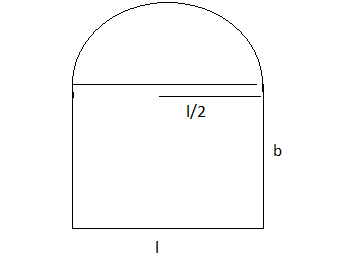
$l+2b + \pi \frac{l}{2} = 10\\ l = \frac{2(10-2b)}{2+\pi}$
Area of window id given by (A) = $lb + \frac{\pi}{2}\left ( \frac{l}{2} \right )^2$
$= \frac{2(10-2b)}{2+\pi}b + \frac{\pi}{2}\left ( \frac{10-2b}{2+\pi} \right )^2\\$
$A^{'}(b) = \frac{20-8b}{2+\pi}+\frac{\pi}{2}.2(\frac{10-2b}{2+\pi}).\frac{(-2)}{2+\pi}$
$= \frac{20-8b}{2+\pi}-2\pi(\frac{10-2b}{(2+\pi)^2})\\ A^{'}(b) = 0\\ \frac{20-8b}{2+\pi}=2\pi(\frac{10-2b}{(2+\pi)^2})\\ 40 + 20\pi -16b -8\pi b = 20\pi - 4\pi b\\ 40 = 4b(\pi+4)\\b = \frac{10}{\pi+4}$
Now,
$A^{''}(b) = \frac{-8}{2+\pi}+\frac{4\pi}{(2+\pi)^2} = \frac{-16-8\pi+4\pi}{(2+\pi)^2} = \frac{-16-4\pi}{(2+\pi)^2} \\ A^{''}(\frac{10}{\pi+4}) < 0$
Hence, b = 5/2 is the point of maxima
$l = \frac{2(10-2b)}{2+\pi} = \frac{2(10-2.\frac{10}{4+\pi})}{2+\pi} = \frac{20}{4+\pi}$
$r= \frac{l}{2}= \frac{20}{2(4+\pi)}=\frac{10}{4+\pi}$
Hence, these are the dimensions of the window to admit maximum light through the whole opening
Question:9 A point on the hypotenuse of a triangle is at distance a and b from the sides of the triangle. Show that the minimum length of the hypotenuse is $( a ^{\frac{2}{3}}+ b ^\frac{2}{3}) ^ \frac{3}{2}$
Answer:
It is given that
A point on the hypotenuse of a triangle is at a distance a and b from the sides of the triangle
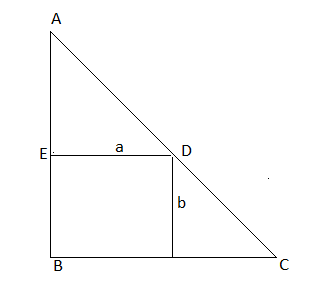 Let the angle between AC and BC is $\theta$
Let the angle between AC and BC is $\theta$
So, the angle between AD and ED is also $\theta$
Now,
CD = $b \ cosec\theta$
And
AD = $a \sec\theta$
AC = H = AD + CD
= $a \sec\theta$ + $b \ cosec\theta$
$\frac{dH}{d\theta} = a \sec\theta\tan\theta - b\cot\theta cosec \theta\\ \frac{dH}{d\theta} = 0\\ a \sec\theta\tan\theta - b\cot\theta cosec \theta =0\\ a \sec\theta\tan\theta = b\cot\theta cosec \theta\\ a\sin^3\theta = b\cos^3\theta\\ \tan^3\theta = \frac{b}{a} \\ \tan\theta = \left ( \frac{b}{a} \right )^\frac{1}{3}$
Now,
$\frac{d^2H}{d\theta^2} > 0$
When $\tan\theta = \left ( \frac{b}{a} \right )^\frac{1}{3}$
Hence, $\tan\theta = \left ( \frac{b}{a} \right )^\frac{1}{3}$ is the point of minima
$\sec \theta = \frac{a\sqrt{a^\frac{2}{3}+b^\frac{2}{3}}}{a^\frac{1}{3}}$ and $cosec \theta = \frac{b\sqrt{a^\frac{2}{3}+b^\frac{2}{3}}}{b^\frac{1}{3}}$
AC = $\frac{a\sqrt{a^\frac{2}{3}+b^\frac{2}{3}}}{a^\frac{1}{3}} +$ $\frac{b\sqrt{a^\frac{2}{3}+b^\frac{2}{3}}}{b^\frac{1}{3}}$ = $(a^\frac{2}{3}+b^\frac{2}{3})^\frac{3}{2}$
Hence proved
Question:10 Find the points at which the function f given by $f(x) = (x-2)^4(x+1)^3$ has (i) local maxima (ii) local minima (iii) point of inflexion
Answer:
Given function is
$f(x) = (x-2)^4(x+1)^3$
$f^{'}(x) = 4(x-2)^3(x+1)^3 + 3(x+1)^2(x-2)^4\\ f^{'}(x)= 0\\ 4(x-2)^3(x+1)^3 + 3(x+1)^2(x-2)^4=0\\ (x-2)^3(x+1)^2(4(x+1) + 3(x-2))\\ x = 2 , x = -1 \ and \ x = \frac{2}{7}$
Now, for value x close to $\frac{2}{7}$ and to the left of $\frac{2}{7}$ , $f^{'}(x) > 0$ ,and for value close to $\frac{2}{7}$ and to the right of $\frac{2}{7}$ $f^{'}(x) < 0$
Thus, point x = $\frac{2}{7}$ is the point of maxima
Now, for value x close to 2 and to the Right of 2 , $f^{'}(x) > 0$ ,and for value close to 2 and to the left of 2 $f^{'}(x) < 0$
Thus, point x = 2 is the point of minima
There is no change in the sign when the value of x is -1
Thus x = -1 is the point of inflexion
Answer: Given function is
$f (x) = \cos ^2 x + \sin x$
$f^{'} (x) = 2\cos x(-\sin x) + \cos x \\ f^{'}(x) = 0\\ -2\cos x\sin x + \cos x=0\\ \cos x(1-2\sin x) = 0\\ either\\ \cos x = 0 \ \ \ \ \ \ and \ \ \ \ \ \ \ \sin x = \frac{1}{2} \\ x = \frac{\pi}{2} \ \ \ \ \ \ \ \ \ \ and \ \ \ \ \ \ \ \ \ \ x = \frac{\pi}{6} \ \ \ \ \ as \ x \ \epsilon [0,\pi]$
Now,
$f^{''} (x) = -2(-\sin x)\sin x - 2\cos x\cos x + (-\sin x) \\ f^{''}(x)= 2\sin^2x - 2\cos^2x - \sin x\\ f^{''}(\frac{\pi}{6}) = \frac{-3}{2} < 0$
Hence, the point $x = \frac{\pi}{6}$ is the point of maxima and the maximum value is
$f (\frac{\pi}{6}) = \cos ^2 \frac{\pi}{6} + \sin \frac{\pi}{6} = \frac{3}{4}+\frac{1}{2} = \frac{5}{4}$
And
$f^{''}(\frac{\pi}{2}) = 1 > 0$
Hence, the point $x = \frac{\pi}{2}$ is the point of minima and the minimum value is
$f (\frac{\pi}{2}) = \cos ^2 \frac{\pi}{2} + \sin \frac{\pi}{2} =0 + 1 = 1$
Answer:
 The volume of a cone (V) = $\frac{1}{3}\pi R^2h$
The volume of a cone (V) = $\frac{1}{3}\pi R^2h$
The volume of the sphere with radius r = $\frac{4}{3}\pi r^3$
By Pythagoras theorem in $\Delta ADC$ we ca say that
$OD^2 = r^2 - R^2 \\ OD = \sqrt{r^2 - R^2}\\ h = AD = r + OD = r + \sqrt{r^2 - R^2}$
V = $\frac{1}{3}\pi R^2 (r + \sqrt{r^2+R^2})\\ = \frac{1}{3}\pi R^2r + \frac{1}{3}\pi R^2 \sqrt{r^2+R^2}$
$\frac{1}{3}\pi R^2 (r + \sqrt{r^2-R^2})\\ V^{'}(R)= \frac{2}{3}\pi Rr + \frac{2}{3}\pi R \sqrt{r^2-R^2}+\frac{1}{3}\pi R^2.\frac{-2R}{2\sqrt{r^2-R^2}}\\ V^{'}(R) = 0\\ \frac{1}{3}\pi R \left ( 2r + 2\sqrt{r^2-R^2} - \frac{R^2}{\sqrt{r^2-R^2}} \right ) = 0\\ \frac{1}{3}\pi R \left ( \frac{2r\sqrt{r^2-R^2} + 2r^2-2R^2 -R^2}{\sqrt{r^2-R^2}} \right ) = 0\\ R \neq 0 \ So, \\ 2r\sqrt{r^2-R^2} = 3R^2 - 2r^2\\ Square \ both \ sides\\ 4r^4-4r^2R^2 = 9R^4 + 4r^4 - 12R^2r^2\\ 9R^4-8R^2r^2 = 0\\ R^2(9R^2-8r^2) = 0\\ R \neq 0 \ So, 9R^2 = 8r^2\\ R = \frac{2\sqrt2r}{3}$
Now,
$V^{''}(R)= \frac{2}{3}\pi r + \frac{2}{3}\pi \sqrt{r^2-R^2}+\frac{2}{3}\pi R.\frac{-2R}{2\sqrt{r^2-R^2}}-\frac{3\pi R^2}{\sqrt{r^2-R^2}} - \frac{(-1)(-2R)}{(r^2+R^2)\frac{3}{2}}\\ V^{''}(\frac{2\sqrt2r}{3}) < 0$
Hence, the point $R = \frac{2\sqrt2r}{3}$ is the point of maxima
$h = r + \sqrt{r^2-R^2} = r + \sqrt{r^2-\frac{8r^2}{9}} = r + \frac{r}{3} = \frac{4r}{3}$
Hence, the altitude of the right circular cone of maximum volume that can be inscribed in a sphere of radius r is $\frac{4r}{3}$
Answer:
Let's do this question by taking an example
suppose
$f(x)= x^3 > 0 , (a.b)$
Now, also
$f{'}(x)= 3x^2 > 0 , (a,b)$
Hence by this, we can say that f is an increasing function on (a, b)
Question:14 Show that the height of the cylinder of maximum volume that can be inscribed in a sphere of radius R is $\frac{2 R }{\sqrt 3 }$ . Also, find the maximum volume.
Answer:
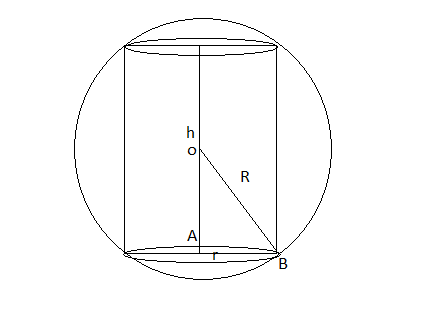 The volume of the cylinder (V) = $\pi r^2 h$
The volume of the cylinder (V) = $\pi r^2 h$
By Pythagoras theorem in $\Delta OAB$
$OA = \sqrt{R^2-r^2}$
h = 2OA
$h = 2\sqrt{R^2-r^2}$
$V = 2\pi r^2\sqrt{R^2-r^2}$
$V^{'}(r) = 4\pi r\sqrt{R^2-r^2}+2\pi r^2 . \frac{-2r}{2\sqrt{R^2-r^2}}\\ V^{'}(r) = 0\\ 4\pi r\sqrt{R^2-r^2}- \frac{2\pi r^3}{\sqrt{R^2-r^2}} = 0\\ 4\pi r (R^2-r^2 ) - 2\pi r^3 = 0\\ 6\pi r^3 = 4\pi rR^2\\ r =\frac{\sqrt6R}{3}$
Now,
$V^{''}(r) = 4\pi \sqrt{R^2-r^2}+4\pi r.\frac{-2r}{2\sqrt{R^2-r^2}}- \frac{6\pi r^2}{\sqrt{R^2-r^2}}.\frac{(-1)-2r}{2(R^2-r^2)\frac{3}{2}}\\ V^{''}(\frac{\sqrt6R}{3}) < 0$
Hence, the point $r = \frac{\sqrt6R}{3}$ is the point of maxima
$h = 2\sqrt{R^2-r^2} = = 2\sqrt{R^2 - \frac{2R^2}{3}} =\frac{2R}{\sqrt3}$
Hence, the height of the cylinder of maximum volume that can be inscribed in a sphere of radius R is $\frac{2 R }{\sqrt 3 }$
and maximum volume is
$V = \pi r^2 h = \pi \frac{2R^2}{3}.\frac{2R}{\sqrt3} = \frac{4\pi R^3}{3\sqrt3}$
$\frac{4}{27}\pi h ^3 \tan ^2 \alpha$
Answer:
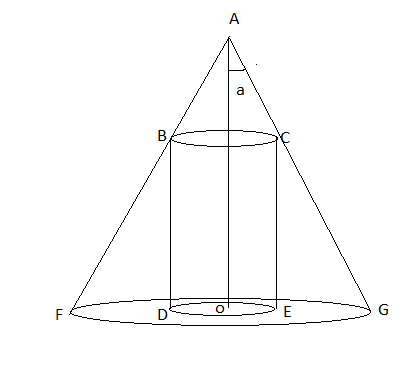 Let's take radius and height of cylinder = r and h ' respectively
Let's take radius and height of cylinder = r and h ' respectively
Let's take radius and height of cone = R and h respectively
Volume of cylinder = $\pi r^2 h'$
Volume of cone = $\frac{1}{3}\pi R^2 h$
Now, we have
$R = h\tan a$
Now, since $\Delta AOG \and \Delta CEG$ are similar
$\frac{OA}{OG} = \frac{CE}{EG}$
$\frac{h}{R} = \frac{h'}{R-r}$
$h'=\frac{h(R-r)}{R}$
$h'=\frac{h(h\tan a-r)}{h\tan a} = \frac{h\tan a- r}{\tan a}$
Now,
$V = \pi r^ 2 h' = \pi r^2 .\frac{h\tan a-r}{\tan a} = \pi r^2 h - \frac{\pi r^3}{\tan a}$
Now,
$\frac{dV}{dr}= 2\pi rh- \frac{3\pi r^2}{\tan a} \\ \frac{dV}{dr}=0\\ 2\pi rh- \frac{3\pi r^2}{\tan a} = 0\\ 2\pi rh = \frac{3\pi r^2}{\tan a}\\ r = \frac{2h\tan a}{3}$
Now,
$\frac{d^2V}{dr^2}= 2\pi h- \frac{6\pi r}{\tan a}$
at $r = \frac{2h\tan a}{3}$
$\frac{d^2V}{dr^2} = 2\pi h- 4\pi h < 0$
Hence, $r = \frac{2h\tan a}{3}$ is the point of maxima
$h' = \frac{h\tan a-r}{\tan a} = \frac{h\tan a- \frac{2h\tan a}{3}}{\tan a}= \frac{1}{3}h$
Hence proved
Now, Volume (V) at $h' = \frac{1}{3}h$ and $r = \frac{2h\tan a}{3}$ is
$V = \pi r^2 h' = \pi \left ( \frac{2h\tan a}{3} \right )^2.\frac{h}{3}= \frac{4}{27}.\pi h^3\tan^2 a$
hence proved
(A) 1 m/h
(B) 0.1 m/h
(C) 1.1 m/h
(D) 0.5 m/h
Answer:
It is given that
$\frac{dV}{dt} = 314 \ m^3/h$
Volume of cylinder (V) = $\pi r^2 h = 100\pi h \ \ \ \ \ \ \ \ \ \ \ (\because r = 10 m)$
$\frac{dV}{dt} = 100\pi \frac{dh}{dt}\\ 314 = 100\pi \frac{dh}{dt}\\ \frac{dh}{dt} = \frac{3.14}{\pi} = 1 \ m/h$
Hence, (A) is correct answer
Also Read,
Topics covered in Chapter 6 Application of Derivatives: Miscellaneous Exercise
- If a quantity $y$ varies with another quantity $x$, satisfying some rule $y=f(x)$, then $\frac{d y}{d x}$ (or $f^{\prime}(x)$ ) represents the rate of change of $y$ with respect to $x$ and $\frac{d y}{d x}{ }_{x=x_0}$ (or $\left.f^{\prime}\left(x_0\right)\right)$ represents the rate of change of $y$ with respect to $x$ at $x=x_0$.
- If two variables $x$ and $y$ are varying with respect to another variable $t$, i.e., if $x=f(t)$ and $y=g(t)$, then by Chain Rule
$\frac{d y}{d x}=\frac{d y}{d t} / \frac{d x}{d t}, \text { if } \frac{d x}{d t} \neq 0$ - A function $f$ is said to be
(a) increasing on an interval $(a, b)$ if $x_1<x_2$ in $(a, b) \Rightarrow f\left(x_1\right)<f\left(x_2\right)$ for all $x_1, x_2 \in(a, b)$. Alternatively, if $f^{\prime}(x) \geq 0$ for each $x$ in $(a, b)$
(b) decreasing on $(a, b)$ if $x_1<x_2$ in $(a, b) \Rightarrow f\left(x_1\right)>f\left(x_2\right)$ for all $x_1, x_2 \in(a, b)$.
(c) constant in $(a, b)$, if $f(x)=c$ for all $x \in(a, b)$, where $c$ is a constant.
- First Derivative Test: Let $f$ be a function defined on an open interval I. Let $f$ be continuous at a critical point $c$ in I. Then
(i) If $f^{\prime}(x)$ changes sign from positive to negative as $x$ increases through c , i.e., if $f^{\prime}(x)>0$ at every point sufficiently close to and to the left of $c$, and $f^{\prime}(x)<0$ at every point sufficiently close to and to the right of $c$, then $c$ is a point of local maxima.
(ii) If $f^{\prime}(x)$ changes sign from negative to positive as $x$ increases through $c$, i.e., if $f^{\prime}(x)<0$ at every point sufficiently close to and to the left of $c$, and $f^{\prime}(x)>0$ at every point sufficiently close to and to the right of $c$, then $c$ is a point of local minima.
(iii) If $f^{\prime}(x)$ does not change sign as $x$ increases through $c$, then $c$ is neither a point of local maxima nor a point of local minima. Such a point is called the point of inflexion.
- Second Derivative Test: Let $f$ be a function defined on an interval I and $c \in \mathrm{I}$. Let $f$ be twice differentiable at $c$. Then
(i) $x=c$ is a point of local maxima if $f^{\prime}(c)=0$ and $f^{\prime \prime}(c)<0$. The value $f(c)$ is the local maximum value of $f$.
(ii) $x=c$ is a point of local minima if $f^{\prime}(c)=0$ and $f^{\prime \prime}(c)>0$. In this case, $f(c)$ is the local minimum value of $f$.
(iii) The test fails if $f^{\prime}(c)=0$ and $f^{\prime \prime}(c)=0$.
Also, read,
NCERT Solutions Subject Wise
These are links to other subjects' NCERT textbook solutions. Students can check and analyse these well-structured solutions for a deeper understanding.
Subject-wise NCERT Exemplar solutions
Students can check these NCERT exemplar links for further practice purposes.
Frequently Asked Questions (FAQs)
10 miscellaneous questions are solved in Class 12 NCERT Mathematics book.
Including miscellaneous, there are 6 exercises. For more questions students can use NCERT exemplar.
51 solved examples are given in the chapter 6 application of derivatives
The questions regarding maximum and minimum of a function using derivatives are covered in the class 12 maths exercise 6.5
Exercise 6.4 and a few questions of Class 12 Maths chapter 6 miscellaneous solutions covers the concept of approximation.
The two tests discussed are the first derivative test and the second derivative test.
Questions related to the tropics rate of change of quantities, approximation, increasing and decreasing functions, tangents and normals and maxima and minima are covered in Class 12 Maths chapter 6 miscellaneous solutions.
24 questions are present in Class 12 Maths chapter 6 miscellaneous exercise solutions
Questions related to CBSE Class 12th
On Question asked by student community
Hello,
You can get the Class 11 English Syllabus 2025-26 from the Careers360 website. This resource also provides details about exam dates, previous year papers, exam paper analysis, exam patterns, preparation tips and many more. you search in this site or you can ask question we will provide you the direct link to your query.
LINK: https://school.careers360.com/boards/cbse/cbse-class-11-english-syllabus
Hello,
No, it’s not true that GSEB (Gujarat Board) students get first preference in college admissions.
Your daughter can continue with CBSE, as all recognized boards CBSE, ICSE, and State Boards (like GSEB) which are equally accepted for college admissions across India.
However, state quota seats in Gujarat colleges (like medical or engineering) may give slight preference to GSEB students for state-level counselling, not for all courses.
So, keep her in CBSE unless she plans to apply only under Gujarat state quota. For national-level exams like JEE or NEET, CBSE is equally valid and widely preferred.
Hope it helps.
Hello,
The Central Board of Secondary Education (CBSE) releases the previous year's question papers for Class 12.
You can download these CBSE Class 12 previous year question papers from this link : CBSE Class 12 previous year question papers (http://CBSE%20Class%2012%20previous%20year%20question%20papers)
Hope it helps !
Hi dear candidate,
On our official website, you can download the class 12th practice question paper for all the commerce subjects (accountancy, economics, business studies and English) in PDF format with solutions as well.
Kindly refer to the link attached below to download:
CBSE Class 12 Accountancy Question Paper 2025
CBSE Class 12 Economics Sample Paper 2025-26 Out! Download 12th Economics SQP and MS PDF
CBSE Class 12 Business Studies Question Paper 2025
CBSE Class 12 English Sample Papers 2025-26 Out – Download PDF, Marking Scheme
BEST REGARDS
Hello,
Since you have passed 10th and 12th from Delhi and your residency is Delhi, but your domicile is UP, here’s how NEET counselling works:
1. Counselling Eligibility: For UP NEET counselling, your UP domicile makes you eligible, regardless of where your schooling was. You can participate in UP state counselling according to your NEET rank.
2. Delhi Counselling: For Delhi state quota, usually 10th/12th + residency matters. Since your school and residency are in Delhi, you might also be eligible for Delhi state quota, but it depends on specific state rules.
So, having a Delhi Aadhaar will not automatically reject you in UP counselling as long as you have a UP domicile certificate.
Hope you understand.
Applications for Admissions are open.
As per latest syllabus. Physics formulas, equations, & laws of class 11 & 12th chapters
JEE Main Important Chemistry formulas
Get nowAs per latest syllabus. Chemistry formulas, equations, & laws of class 11 & 12th chapters
JEE Main high scoring chapters and topics
Get nowAs per latest 2024 syllabus. Study 40% syllabus and score upto 100% marks in JEE
JEE Main Important Mathematics Formulas
Get nowAs per latest syllabus. Maths formulas, equations, & theorems of class 11 & 12th chapters
